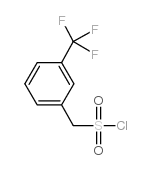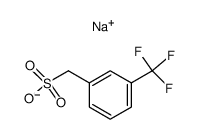127162-96-3
| 中文名 | [3-(三氟甲基)吡啶]甲烷磺酰氯 |
|---|---|
| 英文名 | (3-(Trifluoromethyl)phenyl)methanesulfonyl chloride |
| 中文别名 | [3-(三氟甲基)苯基]甲磺酰氯 |
| 英文别名 |
(3-Trifluoromethylphenyl)methanesulfonyl chloride 3-(Trifluoromethyl)benzenemethanesulfonyl chloride
3-trifluoromethylbenzylsulfonyl chloride MFCD01631932 |
| 密度 | 1.506g/cm3 |
|---|---|
| 沸点 | 293.5ºC at 760mmHg |
| 熔点 | 173 °C |
| 分子式 | C8H6ClF3O2S |
| 分子量 | 258.64500 |
| 闪点 | 131.3ºC |
| 精确质量 | 257.97300 |
| PSA | 42.52000 |
| LogP | 3.85480 |
| 蒸汽压 | 0.00549mmHg at 25°C |
| 折射率 | 1.494 |
| 储存条件 | 2-8℃ |
| 分子结构 | 1、摩尔折射率:50.02 2、摩尔体积(cm3/mol):171.6 3、等张比容(90.2K):422.9 4、表面张力(dyne/cm):36.8 5、介电常数:无可用的 6、极化率(10-24cm3):19.83 7、单一同位素质量:257.972912 Da 8、标称质量:258 Da 9、平均质量:258.6452 Da |
| 计算化学 | 1.疏水参数计算参考值(XlogP):无 2.氢键供体数量:0 3.氢键受体数量:5 4.可旋转化学键数量:2 5.互变异构体数量:无 6.拓扑分子极性表面积42.5 7.重原子数量:15 8.表面电荷:0 9.复杂度:307 10.同位素原子数量:0 11.确定原子立构中心数量:0 12.不确定原子立构中心数量:0 13.确定化学键立构中心数量:0 14.不确定化学键立构中心数量:0 15.共价键单元数量:1 |
| 更多 | 1. 性状:未确定 2. 密度(g/mL,20℃):未确定 3. 相对蒸汽密度(g/mL,空气=1):未确定 4. 熔点(ºC):173 5. 沸点(ºC,常压):未确定 6. 沸点(ºC,KPa):未确定 7. 折射率:未确定 8. 闪点(ºC):未确定 9. 比旋光度(º):未确定 10. 自燃点或引燃温度(ºC):未确定 11. 蒸气压(Pa,20ºC):未确定 12. 饱和蒸气压(KPa,20ºC):未确定 13. 燃烧热(KJ/mol):未确定 14. 临界温度(ºC):未确定 15. 临界压力(KPa):未确定 16. 油水(辛醇/水)分配系数的对数值:未确定 17. 爆炸上限(%,V/V):未确定 18. 爆炸下限(%,V/V):未确定 19. 溶解性:未确定 |
Synonym:None Known Section 2 - COMPOSITION, INFORMATION ON INGREDIENTS
Risk Phrases: 14 34 Section 3 - HAZARDS IDENTIFICATION EMERGENCY OVERVIEW
Reacts violently with water. Causes burns.Water-reactive. Potential Health Effects Eye: Causes eye burns. Skin: Causes skin burns. Ingestion: Causes gastrointestinal tract burns. Inhalation: Causes chemical burns to the respiratory tract. Chronic: Chronic exposure may cause effects similar to those of acute exposure. Section 4 - FIRST AID MEASURES Eyes: In case of contact, immediately flush eyes with plenty of water for at least 15 minutes. Get medical aid immediately. Skin: If water-reactive products are embedded in the skin, no water should be applied. The embedded products should be covered with a light oil. In case of contact, immediately flush skin with plenty of water for at least 15 minutes while removing contaminated clothing and shoes. Get medical aid immediately. Wash clothing before reuse. Ingestion: If swallowed, do NOT induce vomiting. Get medical aid immediately. If victim is fully conscious, give a cupful of water. Never give anything by mouth to an unconscious person. Inhalation: Get medical aid immediately. Remove from exposure and move to fresh air immediately. If breathing is difficult, give oxygen. Do NOT use mouth-to-mouth resuscitation. If breathing has ceased apply artificial respiration using oxygen and a suitable mechanical device such as a bag and a mask. Notes to Physician: Section 5 - FIRE FIGHTING MEASURES General Information: As in any fire, wear a self-contained breathing apparatus in pressure-demand, MSHA/NIOSH (approved or equivalent), and full protective gear. During a fire, irritating and highly toxic gases may be generated by thermal decomposition or combustion. Water Reactive. Material will react with water and may release a flammable and/or toxic gas. Extinguishing Media: Use dry sand or earth to smother fire. DO NOT USE WATER! Do NOT get water inside containers. Contact professional fire-fighters immediately. Cool containers with flooding quantities of water until well after fire is out. Use water spray, dry chemical, carbon dioxide, or appropriate foam. Section 6 - ACCIDENTAL RELEASE MEASURES General Information: Use proper personal protective equipment as indicated in Section 8. Spills/Leaks: Clean up spills immediately, observing precautions in the Protective Equipment section. Avoid generating dusty conditions. Provide ventilation. Do not expose spill to water. Vacuum or sweep up material and place into a suitable, dry disposal container. Section 7 - HANDLING and STORAGE Handling: Minimize dust generation and accumulation. Do not breathe dust, vapor, mist, or gas. Do not get in eyes, on skin, or on clothing. Keep container tightly closed. Do not ingest or inhale. Do not allow contact with water. Discard contaminated shoes. Keep from contact with moist air and steam. Use only with adequate ventilation. Storage: Keep container closed when not in use. Keep away from water. Store protected from moisture. Store under an inert atmosphere. Section 8 - EXPOSURE CONTROLS, PERSONAL PROTECTION Engineering Controls: Use explosion-proof ventilation equipment. Facilities storing or utilizing this material should be equipped with an eyewash facility and a safety shower. Use adequate ventilation to keep airborne concentrations low. Exposure Limits CAS# 127162-96-3: Personal Protective Equipment Eyes: Wear appropriate protective eyeglasses or chemical safety goggles as described by OSHA's eye and face protection regulations in 29 CFR 1910.133 or European Standard EN166. Skin: Wear appropriate protective gloves to prevent skin exposure. Clothing: Wear appropriate protective clothing to prevent skin exposure. Respirators: A respiratory protection program that meets OSHA's 29 CFR 1910.134 and ANSI Z88.2 requirements or European Standard EN 149 must be followed whenever workplace conditions warrant respirator use. Follow the OSHA respirator regulations found in 29 CFR 1910.134 or European Standard EN 149. Use a NIOSH/MSHA or European Standard EN 149 approved respirator if exposure limits are exceeded or if irritation or other symptoms are experienced. Section 9 - PHYSICAL AND CHEMICAL PROPERTIES Physical State: Solid Color: white Odor: Not available. pH: Not available. Vapor Pressure: Not available. Viscosity: Not available. Boiling Point: Not available. Freezing/Melting Point: 57-59 deg C Autoignition Temperature: Not available. Flash Point: Not available. Explosion Limits, lower: Not available. Explosion Limits, upper: Not available. Decomposition Temperature: Solubility in water: Specific Gravity/Density: Molecular Formula: C8H6ClF3O2S Molecular Weight: 258.653 Section 10 - STABILITY AND REACTIVITY Chemical Stability: Stable at room temperature in closed containers under normal storage and handling conditions. Combines vigorously or explosively with water. Conditions to Avoid: Dust generation, moisture, exposure to moist air or water. Incompatibilities with Other Materials: Oxidizing agents, bases, amines, water. Hazardous Decomposition Products: Hydrogen chloride, carbon monoxide, oxides of sulfur, carbon dioxide, hydrogen fluoride gas. Hazardous Polymerization: Has not been reported Section 11 - TOXICOLOGICAL INFORMATION RTECS#: CAS# 127162-96-3 unlisted. LD50/LC50: Not available. Carcinogenicity: [3-(Trifluoromethyl)phenyl]methanesulfonyl chloride - Not listed by ACGIH, IARC, or NTP. Section 12 - ECOLOGICAL INFORMATION Ecotoxicity: Fish: Pseudomonas putida: Section 13 - DISPOSAL CONSIDERATIONS Dispose of in a manner consistent with federal, state, and local regulations. Section 14 - TRANSPORT INFORMATION IATA Shipping Name: CORROSIVE SOLID, WATER-REACTIVE, N.O.S. Hazard Class: 8 UN Number: 3096 Packing Group: II IMO Shipping Name: CORROSIVE SOLID, WATER-REACTIVE, N.O.S. Hazard Class: 8 UN Number: 3096 Packing Group: II RID/ADR Shipping Name: CORROSIVE SOLID, WATER-REACTIVE, N.O.S. Hazard Class: 8 UN Number: 3096 Packing group: II Section 15 - REGULATORY INFORMATION European/International Regulations European Labeling in Accordance with EC Directives Hazard Symbols: C Risk Phrases: R 14 Reacts violently with water. R 34 Causes burns. Safety Phrases: S 6 Keep under nitrogen. S 26 In case of contact with eyes, rinse immediately with plenty of water and seek medical advice. S 36/37/39 Wear suitable protective clothing, gloves and eye/face protection. WGK (Water Danger/Protection) CAS# 127162-96-3: No information available. Canada None of the chemicals in this product are listed on the DSL/NDSL list. CAS# 127162-96-3 is not listed on Canada's Ingredient Disclosure List. US FEDERAL TSCA CAS# 127162-96-3 is not listed on the TSCA inventory. It is for research and development use only. SECTION 16 - ADDITIONAL INFORMATION N/A |
| 符号 |

GHS07 |
|---|---|
| 信号词 | Warning |
| 危害声明 | H302 |
| 警示性声明 | P280-P305 + P351 + P338-P310 |
| 危害码 (欧洲) | Xi: Irritant; |
| 风险声明 (欧洲) | 34 |
| 安全声明 (欧洲) | S26-S36/37/39 |
| 危险品运输编码 | 3261 |
| 海关编码 | 2904909090 |
|
~% 
127162-96-3 |
| 文献:US4831179 A1, ; US4885027 A1, ; |
| 海关编码 | 2904909090 |
|---|---|
| 中文概述 | 2904909090 其他烃的磺化、硝化、亚硝化衍生物(不论是否卤化). 增值税率:17.0% 退税率:9.0% 监管条件:无 最惠国关税:5.5% 普通关税:30.0% |
| 申报要素 | 品名, 成分含量, 用途 |
| Summary | HS:2904909090 sulphonated, nitrated or nitrosated derivatives of hydrocarbons, whether or not halogenated VAT:17.0% Tax rebate rate:9.0% Supervision conditions:none MFN tariff:5.5% General tariff:30.0% |


